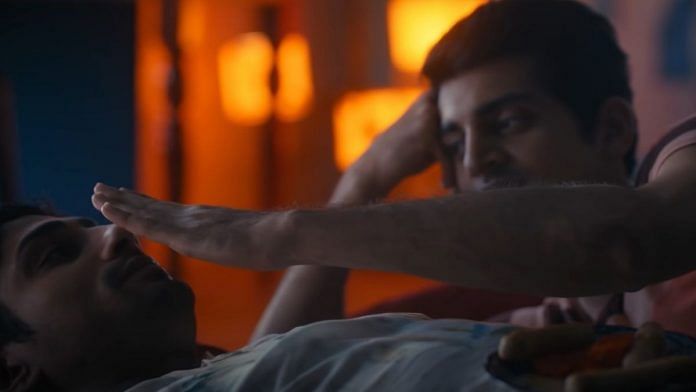Netflix’s Cobalt Blue will stain your memory long after the movie has ended. It is striking, especially in the history of LGBTQ+ communities’ representation in Indian cinema. The last commercial film that touched on the subject of queerness, Badhaai Do, left a lot to be desired. It’s not that Cobalt Blue is flawless, but it has a beating heart that makes up for a lot of its shortcomings.
A quick search will show you that the story is about a brother and sister, played by Neelay Mehendale and Anjali Sivaraman, in a ‘traditional Marathi family’ who fall in love with the unnamed character played by Prateik Babbar. But that’s not even the tip of the iceberg.
The film is directed by National Award-winner Sachin Kundalkar and is based on his own breakthrough debut novel of the same name that he wrote when he was 22. The Marathi original was later translated into English by the elusive Jerry Pinto. In directing a movie based on his own book, and also, an extremely sensitive and poignant portrayal of love and sexual awakening, Cobalt Blue is similar to Stephen Chbosky’s The Perks of Being a Wallflower (2012).
Also Read: Shubh Mangal Zyada Saavdhan review: Perfect primer for Indians to talk about homosexuality
Men in Cobalt Blue
Prateik Babbar, in a career-best performance, plays the enigmatic paying guest who both Tanay (Mehendale) and Anuja (Sivaraman) fall in love with. He brings the colour blue and rainbows into the lives of the siblings.
Tanay is an aspiring author, who longs for a room of his own and talks to his turtle, Pablo. Prateik’s character, meanwhile, is seen only through Tanay’s eye. Right at the beginning, he describes himself as someone who makes lamps and sells them. He is an artist, who uses various mediums and colours, as he interacts with the two siblings.
The love-making scenes between the two men in Cobalt Blue are sensual, poignant and treated with extreme tenderness. From the moment Tanay leans in to inhale Prateik’s scent to when they finally kiss and have sex, every frame stays with you.
The scenes of Tanay and his lonely professor — expertly played by Neil Bhoopalan — sharing their trauma with each other are crushing because the story, set in 1996 Kochi, is far removed from the world of today. In the realm of Cobalt Blue, loving a person of the same gender was still a crime. There were no dating apps or other ways of finding love without being brutally punished for it.
The character of Tanay tugs at you with the multitude of his emotions and desires, struggling to break free in a world polarised by communism, on one hand, and his father’s iron fist on the other. The scenes of him flirting with Bhoopalan’s character act as a foreshadowing of what is to come after Prateik’s introduction to the story.
The extremities of patriarchy and violence are evident in Tanay’s father and the dead grandfather, who use their privilege to brutally ensure the status quo, especially for women.
Also Read: New OTT rules won’t stop Bollywood’s queer stories – Geeli Pucchi to The Married Women
Women of Cobalt Blue
In the novel, the chapters are divided into ‘His’ and ‘Hers’ — giving voice to the individual experiences of Tanay and Anuja’s sexual interactions with Prateik’s character. In both, however, you do not get to hear enough about what Anuja had to say, which is a big drawback in the film.
But what stands out in Cobalt Blue is the solidarity between the three main female characters in the film — a Muslim, a Hindu and a Christian — all subjugated in some way, and yet, never failing, even once, to stand up and help others fulfil their dreams.
There is a beautiful moment when Anuja gets her periods and her friend Fathima drives her home on a Bullet, while Mary sits behind her to hide the stain. It is also Mary who is determined to save and help Anuja achieve her dream of being a hockey player when things break loose in the Tanay-Anuja household.
The setting of the film is picture-perfect — Kerala’s backwaters, spice godowns and even the sea. The colour palette is stunning and complements the first flush of sexual awakening of the brother-sister duo. In that sense, perhaps quite aptly, blue is indeed the warmest colour.
The Cobalt Blue never makes a hero of anyone, but hinges primarily on what love and loss mean, and, as Anuja says, ‘love makes you braver’.
(Edited by Srinjoy Dey)




